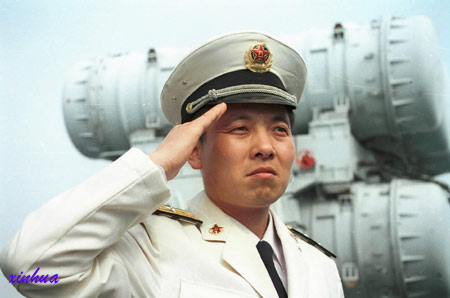
Who Will Command China’s Aircraft Carriers?
Publication: China Brief Volume: 11 Issue: 12
By:

China has reportedly postponed the sea trial of its long-awaited aircraft carrier to an unspecified date in August. The Varyag, which was purchased from Ukraine and is under refurbishment at Dalian port, was widely believed to set sail on July 1 for a trial run. Ostensibly to demonstrate the Party’s indispensible role in bringing about the “new China,” the date of the sea trial for China’s maiden carrier was apparently planned to coincide with the 90th birthday of the Chinese Communist Party (CCP). Yet, due to mechanical difficulties or, in part, Beijing’s concerns about regional anxieties over growing tensions in the South China Sea, the sea trial was reportedly delayed (Focus Taiwan News, June 30).
The rollout of China’s maiden carrier has been widely touted as a symbolic demonstration of the nation’s growing strength and maritime aspirations. To be sure, a single carrier has limited capabilities and, for that matter, limited utility in near-term tactical missions, and its development required a significant investment of economic as well as political resources. Conventional wisdom on China’s carrier plan suggests that the Chinese leadership did not put enough planning in personnel development, and therefore will face a lot of difficulties in operating a carrier group. A review of the training programs developed to cultivate the commanders for its aircraft carriers suggest an ambitious, meticulous and long-term strategy, however.
On March 31, 1987, Admiral Liu Huaqing, the People’s Liberation Army (PLA) Navy commander (1982-1988), submitted an internal memo to the PLA Staff Headquarters and National Defense Technology and Industry Committee on developing the core strengths of the PLAN, which included developing aircraft carriers and nuclear submarines (China Review News, May 22, 2009). According to a Jiefangjun Bao (PLA Daily) article in 2008, the Central Military Commission in May 1987 initiated the first and only “Pilot Warship Captain Class” (feixingyuan jianchang ban) at the Guangzhou Warship Academy. The program selected the military’s most talented pilots to undergo surface warship vessels leadership training. In other words, the Chinese military has been training navy pilots as aircraft carrier ship captains since 1987 (Sina.com.cn, June 26). Ten naval aviation pilots were apparently selected to attend the pilot training program. Nine pilots went through three and half to four years of training in naval aviation command, and were stationed in different command units to serve as deputy captains and then became captains of their aviation wings (Sina.com.cn, June 26).
The aircraft carrier program was delayed and these pilots were retrained and reassigned for destroyer commands. Most of these destroyer commanders are qualified naval pilots. This training background establishes a link between the Chinese aircraft carrier and destroyer—many captains and their deputies of Chinese destroyers were former naval pilots and are thus ideal candidates to serve as captains of China’s aircraft carriers (Sina.com.cn, June 26). They have already gone through intensive training, and served on board naval vessels after graduating. Now most of them have close to 20 years of joint training experience, and serve essentially as the backbone of China’s surface warship fleet. For example, Bai Yaoping is widely speculated to become the Chinese carrier commander. As a member of the class of ‘87 at the Guangzhou Warship Academy, most of the students who attended this class are close to their 50s, and to varying degrees have set the Navy’s standard as potential commanders. They are at a prime age and experience; most of them hold military ranks that are above colonel or senior colonel (Sina.com.cn, June 26).
The time and preparation that the Chinese leadership invested in cultivating these personnel may be one indication of a robust carrier plan. The time required to train and develop experience and skills is arguably longer than the development of some military technologies. While there are many variables involved in ensuring the operational success and effectiveness of an aircraft carrier not the least a carrier group, it appears that the command aspect of these vessels may not be a major issue. To be sure, there remains a long period of training, development and joint exercises before the carrier becomes fully operational. Yet, the prestige and importance that the Chinese leadership attaches to the carrier program should not be understated. Given the political capital that the Chinese leadership has clearly invested in the program, its funding and development would not easily be shelved again. Furthermore, there are indications that China may already be cultivating the subsequent batch of captains and pilots for its next fleet of carriers (See "PLA Navy Expands Recruitment Drive to Enhance Operational Capability," China Brief, May 20). Indeed, the pending sea trial for the Varyag will mark an important milestone as the first step in China’s effort toward becoming a global naval power.





